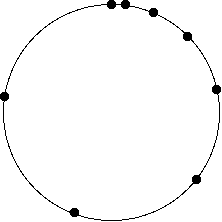Doron, time of reckoning has arrived . . . LOL. Get your brain ready, for the nuts and bolts mathematics knocks on the door. This time a number is needed -- no more words dressed in a fancy evening gown. The number drives Infinity, and so all ten digits of a human hand are not enough to catch the number speeding. I shall paint the picture with no delay and no mercy. Either you pull the number like a rabbit from the hat of the deepest knowledge, or you are the Conjurer Grande.
First, we build the road that has no end . . .
1/1, 1/2, 1/3, 1/4, 1/5, . . .
2/1, 2/2, 2/3, 2/4, 2/5, . . .
3/1, 3/2, 3/3, 3/4, 3/5, . . .
4/1, 4/2, 4/3, 4/4, 4/5, . . .
5/1, 5/2, 5/3, 5/4, 5/5, . . .
. . . . .
. . . . .
. . . . .
The pattern of development is apparent -- anyone can continue the fractions in columns and rows all the way toward infinity.
So we have a set of distinct fractions -- there are no two identical fractions as far as identity between numerators and denominators is concerned, as the matrix grows larger and approaches infinity. And now we will create a subset. This subset is made of all fractions which can be reduced. 4/2 and 2/1 are two different fractions on the nominal level, but on the ordinal level 4/2 = 2/1.
And so, some of the fractions in the set can be reduced, some of them not. Now the question bursts in like a tornado through the closed curve -- I mean the window: What is the ratio between those fractions that cannot be reduced and those that can, as the value of the members of the set is approaching infinity?
I hope that you would be able to figure this out and come up with the number in the approximate form with the precision of ten decimal digits. Good luck.
First, we build the road that has no end . . .
1/1, 1/2, 1/3, 1/4, 1/5, . . .
2/1, 2/2, 2/3, 2/4, 2/5, . . .
3/1, 3/2, 3/3, 3/4, 3/5, . . .
4/1, 4/2, 4/3, 4/4, 4/5, . . .
5/1, 5/2, 5/3, 5/4, 5/5, . . .
. . . . .
. . . . .
. . . . .
The pattern of development is apparent -- anyone can continue the fractions in columns and rows all the way toward infinity.
So we have a set of distinct fractions -- there are no two identical fractions as far as identity between numerators and denominators is concerned, as the matrix grows larger and approaches infinity. And now we will create a subset. This subset is made of all fractions which can be reduced. 4/2 and 2/1 are two different fractions on the nominal level, but on the ordinal level 4/2 = 2/1.
And so, some of the fractions in the set can be reduced, some of them not. Now the question bursts in like a tornado through the closed curve -- I mean the window: What is the ratio between those fractions that cannot be reduced and those that can, as the value of the members of the set is approaching infinity?
I hope that you would be able to figure this out and come up with the number in the approximate form with the precision of ten decimal digits. Good luck.


